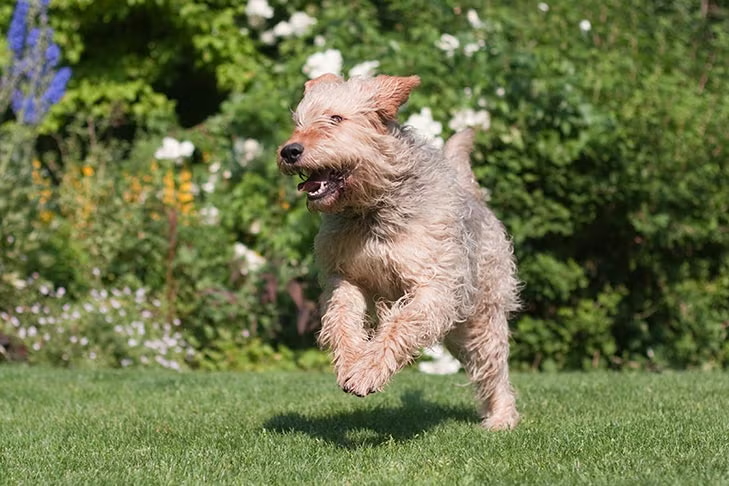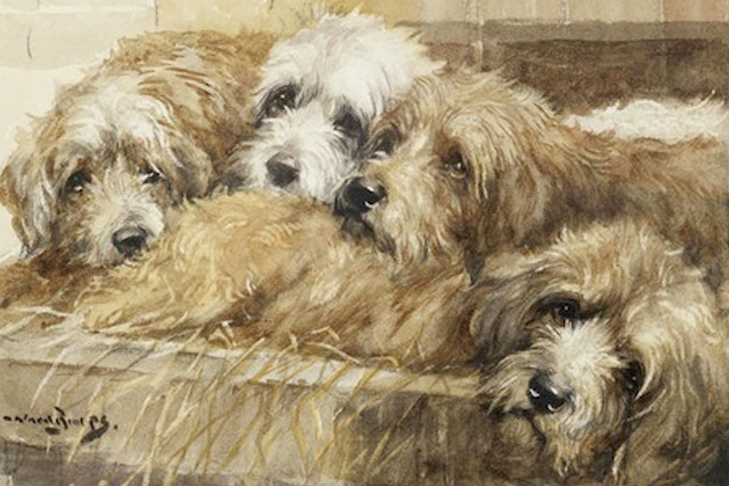If you’ve been following the latest trends in dog breeds, you’ve likely heard of the popular “doodle” mixes—Labradoodles, Goldendoodles, and their many variations. With their shaggy coats and friendly personalities, these crossbreeds are loved by many, but if you’re searching for something a little different—something with a bit more history, a strong sense of purpose, and a breed that hasn’t been overhauled by trendy crossbreeding—then the Otterhound might just be the dog for you.
While doodles have become the “designer dogs” of choice for many families, a rare and hardworking breed, the Otterhound, is quietly fighting for its survival. With fewer than 1,000 Otterhounds left in the world, this breed, once essential for hunting otters, is in danger of vanishing forever. As the popularity of doodles grows, the Otterhound, with its unique skills and charming disposition, remains a breed that deserves much more attention.

What Makes Otterhounds Different from Doodles?
The rising trend of designer dog breeds, such as Labradoodles and Goldendoodles, has led to a surge in demand for dogs with specific looks and temperaments. These crossbreeds are often bred for the purpose of combining desirable traits, like low-shedding coats and friendly temperaments, in the hopes of creating the perfect family dog. However, despite their popularity, the mixed breeds of today often come with more unpredictability in terms of appearance, coat type, and behavior. Some may shed more than expected or inherit characteristics that don’t mesh well with family life.
In contrast, the Otterhound is a breed that is rooted in tradition and consistency. Developed as a working scent hound, Otterhounds were specifically bred to track and hunt otters—animals that were once considered a threat to fish populations in the British Isles. With their waterproof coats, large feet with webbing, and remarkable sense of smell, Otterhounds excelled at tracking prey in both land and water environments.
Unlike the doodle breeds, Otterhounds have a predictable appearance and temperament. They are large, shaggy dogs with long, flowing coats that shed less than most dogs and require minimal grooming—just a weekly combing and brushing. Their friendly and independent nature makes them wonderful companions for families and individuals alike. They are also known for their great noses, inherited from their Bloodhound and Welsh Foxhound ancestors, and their ability to work well in a variety of settings, from therapy work to tracking and trailing.

The Decline of the Otterhound
Despite their versatility and appealing nature, the Otterhound is in danger of becoming extinct. With fewer than 1,000 Otterhounds left worldwide, this breed is considered endangered. While some breeds, like the Labradoodle, are in high demand and easy to find, Otterhounds are facing a slow but steady decline. Their role in hunting otters has long since been diminished due to the protection of otters, and many people today are unaware of the Otterhound’s historical significance and practical skills.
At the same time, the popularity of designer mixes like doodles has skyrocketed. These crossbreeds, often bred for looks and less for function, are seeing a surge in popularity, with owners seeking out dogs that have the appearance of certain breeds without the mess or shedding. While the intention behind breeding doodles may be to combine the best of both worlds, the reality is that these dogs often inherit a mix of traits, some of which can be more difficult to manage than expected.
This rising demand for “designer dogs” has left traditional breeds like the Otterhound struggling to maintain their numbers and preserve their place in history. But the Otterhound’s qualities—such as its excellent scenting ability, friendly disposition, and ability to perform multiple tasks—make it a breed worth saving.
The Versatility of the Otterhound
Otterhounds are not just beautiful and unique; they are also incredibly versatile dogs. Historically bred to track otters, they are natural-born scent hounds, which makes them well-suited for jobs such as search-and-rescue, tracking, and trailing. Their amazing sense of smell, combined with their social nature, also makes them perfect candidates for therapy dog work. Many Otterhounds are employed as therapy dogs in nursing homes, hospitals, and schools, providing comfort and companionship to people in need.

These dogs are also excellent companions, known for their gentle and friendly demeanor. They are good with children, other dogs, and even cats. Otterhounds enjoy being part of a family and are known for their loyal and affectionate nature. But they are also independent thinkers, which means they require a certain level of patience and understanding in training. They have a strong work ethic and enjoy having a “job,” whether it’s tracking a scent or simply being part of the family’s daily activities.
Why Consider an Otterhound Over a Doodle?
While the appeal of a Labradoodle or Goldendoodle is undeniable, the Otterhound offers a compelling alternative for those looking for a dog with a unique heritage, reliable temperament, and natural working abilities. Here are some reasons to consider an Otterhound instead of a designer breed:
- Predictable Appearance and Temperament: Unlike doodles, which can vary widely in appearance and personality, Otterhounds have a consistent look and behavior. They are friendly, independent, and great with families.
- Low Maintenance Grooming: While doodles require regular grooming and maintenance due to their coats, Otterhounds shed less and only need a weekly brushing. Their coats are naturally water-resistant, making them easy to maintain.
- Natural Abilities: Otterhounds are natural scent hounds with exceptional tracking abilities. They can work in a variety of roles, from therapy dog to search-and-rescue to simply being a loyal family companion.
- Preserving a Rare Breed: The Otterhound is an endangered breed, with fewer than 1,000 dogs left in the world. By choosing an Otterhound, you are helping preserve a unique and valuable breed with a rich history.
Conclusion
As the trend for designer breeds continues to rise, it’s important to remember the value of traditional breeds like the Otterhound. These dogs may not be as trendy or as popular as the latest doodle mixes, but they offer a wealth of skills, a rich history, and a loyal, loving personality that make them exceptional pets. With fewer Otterhounds left in the world, now is the time to consider adopting one of these remarkable dogs and ensuring that this hardworking, sociable breed doesn’t disappear.


